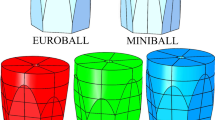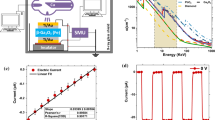Abstract
In this paper the characterization of a GaAs X-ray pixel detector is presented. The performance is obtained experimentally by a detector using a Schottky diode on a semi-insulating, Vertical Gradient Freeze, (100) oriented single crystal GaAs substrate. Moreover, a new 3D Model based on the Finite Element Method is shown which takes into account the carrier trapping and emission phenomena. The model analyzes the single event upset for a photon hitting the pixel surface in any direction. The main advantage of the model used is its ability to determine the influence of both the position of the impact point and of the slope of the particle trajectory with respect to the pixel surface on the detector performance. The numerical simulations obtained confirm the experimental values and permit the indirect evaluation of the charge collection efficiency through a preliminary determination of the real trap distribution and transport parameters depending on the electric field.
Similar content being viewed by others
References
M.E. Fantacci, Proc. of 3rd International Workshop on Gallium Arsenide and Related Components, (University of Glasgow, Scotland, 1996), pp. 225–231.
W. Bencivelli, E. Bertolucci, U. Bottigli, A. Cola, M.E. Fantacci, P. Rizzo, V. Rosso, and A. Stefanini, Nuclear Instuments and Methods in Physics Research, A-346, 372–378 (1994).
E. Vittone, C. Manfredotti, F. Fizzotti, K. Mirri, E. Gargioni, P. Polesello, A. Lo Giudice, S. Galassini, F. Nava, P. Vanni, and P. Rossi, Nuclear Instuments and Methods in Physics Research, B-158, 470–475 (1999).
D.R. Dance, in “The Physics of Medical Imaging” edited by S. Webb, (IOP Publishing, Philadelphia, 1990), 35, p. 27.
E. Bertolucci, Proc. of 3rd International Workshop on Gallium Arsenide and Related Components(University of Glasgow, Scotland, 1996), pp. 211–216.
P. Randaccio, Nuclear Instuments and Methods in Physics Research, A-310, 210–214 (1991).
D.S. McGregor, and G.F. Knoll, Nuclear Instuments and Methods in Physics Research, A-322, 487–492 (1996).
G Bertuccio, R. Casiraghi, D. Maiocchi, A. Owens, M. Bavdaz, A. Peacock, H. Andersson, and S. Nenonen, IEEE Trans. on Nuclear Science, 50, 723–728 (2003).
M. Rizzi, V. Antonicelli, and B. Castagnolo, IEE Proceedings on Circuits, Devices and Systems, 150, 210–216 (2003).
T.E. Schlesinger and R.B. James, Semiconductors And Semimetals, Accademy Press Inc., 43, 3–7 (1995).
M. Campell, E.H. Heijne, G. Meddeler, E. Pernigotti, and W. Snoeys, IEEE Transactions on Nuclear Sciences, 45, 751 (1998).
W. Hackbusch, Multi-grid Methods and Applications(Springer-Verlag, Berlin, 1985).
H.C. Elman et al., “A Multigrid method enhanced by Krylov subspace iteration for discrete Helmholtz equations”, SIAM J. Sci. Comp., 23, pp. 1291–1315, 2001.
J. Nocedal, J. and S.J. Wright, Numerical Optimization, Springer Series in Operations Research(Springer Verlag, 1999).
P. De Visschere, Solid State Electronics, 4, 455–459 (1990).
H. Kim, H.S. MIN, W. Tang, and Y.J. Park, Solid State Electronics, 34, 1251–1253 (1991).
D.S. McGregor and D.A. Rojeski, Journal of Applied Physics, 75, 7910 (1994).
A. Cola, F. Quaranta, L. Vasanelli, C. Canali, A. Cavallini, F. Nava, and M.E. Fantacci, Nuclear Instruments and Methods in Physics Research, A390, 345–349 (1997).
A. Cola, F. Quaranta, M.A. Ciocci, and M.E. Fantacci, Nuclear Instruments and Methods, A380, 66–69 (1996).
S.P. Beaumont, F. Foster, G. Hughes, B.K. Jones, J. Santana I. J. Saunders, and T. Sloan, Nuclear Instruments and Methods in Physics Research, A322, 472–482 (1992).
B.L. Sharma, Metal-semiconductor Schottky barrier junction and their applications(Plenium Press, New York, 1984).
Author information
Authors and Affiliations
Corresponding author
Rights and permissions
About this article
Cite this article
Rizzi, M., Maurantonio, M. & Castagnolo, B. GaAs X-ray detector characterization through a 3D finite element model. J Comput Electron 5, 27–34 (2006). https://doi.org/10.1007/s10825-006-7916-4
Received:
Revised:
Accepted:
Issue Date:
DOI: https://doi.org/10.1007/s10825-006-7916-4




